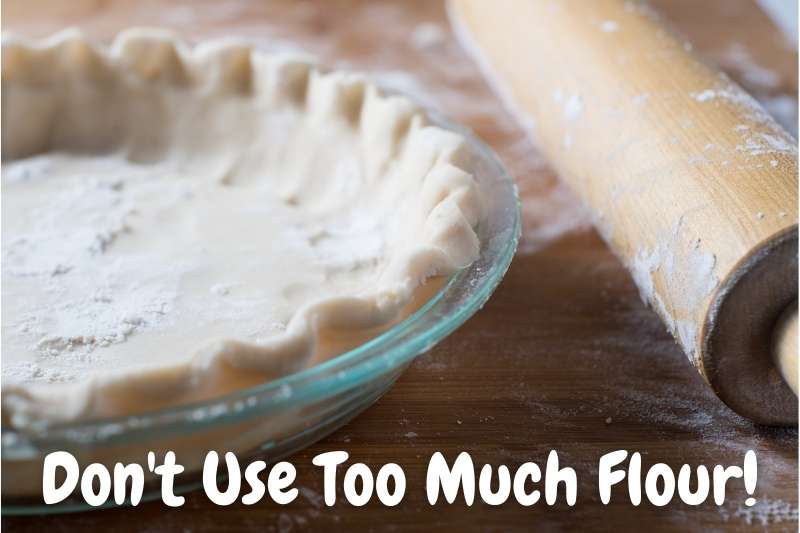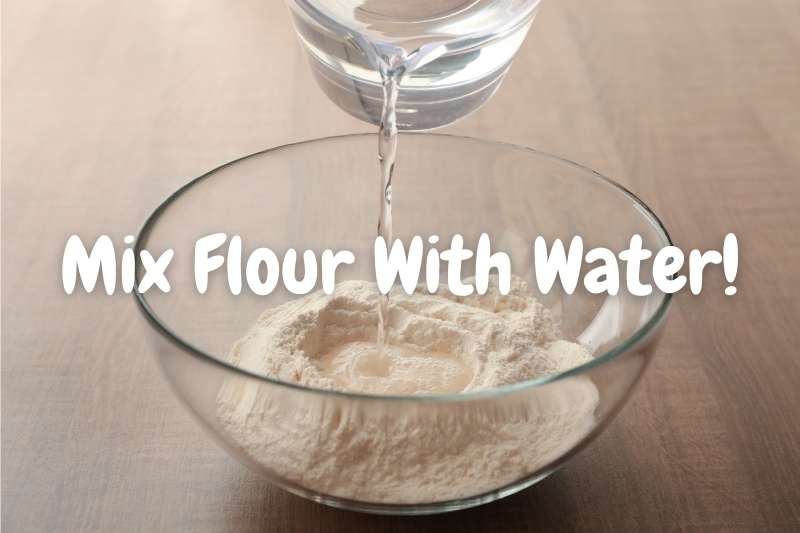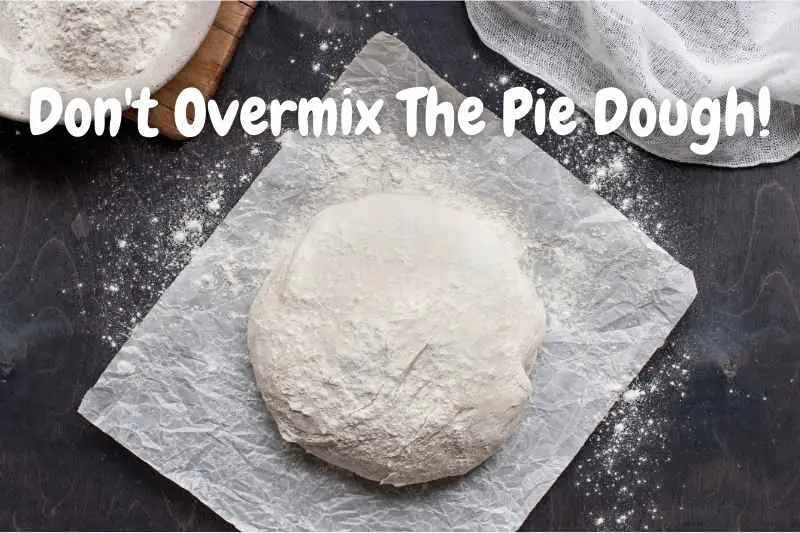This post contains affiliate links.
Nobody likes a pie crust that cracks in the oven. Not only does it look poorly baked, but it can also make your pie filling leak out. In the past, I figured out some ways to prevent your pie crusts from cracking, as well as how to fix them if they do happen to crack!
To fix pie crusts that have cracked in the oven, mix together water and flour. This creates a thick consistency that can be used to fill any cracks and gaps that have formed while prebaking your pie crust. Bake for an additional 5-7 minutes until the dough matches the color of the crust.
This technique seems simple enough to use but the most important aspect of baking is preventing these problems from happening in the first place! Read on to find out how to prevent cracks from forming.
Why Did My Pie Crust Crack In The Oven?
As a general rule, the main reason for pie crust cracking in the oven is the oven being too hot. When this happens, the butter or shortening in your crust melts too quickly, causing the dough to become gummy and tough. As a result, the pie crust contracts and leaves cracks in the dough.
Over the years, I have found many reasons why my pie crusts cracked. Here are some of the reasons:
You Used Too much flour
When there’s too much flour when rolling out the dough, it dries out the dough and makes it difficult to stretch. As a result, you end up with a crust that’s more likely to crack.

Too Much Flour Will Make Your Crust Crack!
You Over-handled the dough
When you handle the dough too much, it also dries out and becomes difficult to stretch. The same thing happens with too much flour – you end up with a crust that’s more likely to crack.
Overhandling simpling means you overworked it when mixing or kneading the dough. once all of your ingredients are incorporated, you can roll it out.
I usually specifically look for Glass Baking Pans that are allowed to be used in the oven. I recently came across a Set of Glass Pie plates for Baking Pie on Amazon that works great for baking pies! You can check out this Glass Pie Pan Set here!
You Rolled the dough too thin or thick
If you roll out the dough too thin, it can become brittle and crack. If you roll it out too thick, the crust will be tough and also more likely to crack. The perfect thickness of crust should be around 1/8″ (or the width of two quarters stacked on top of each other).
There’s Not enough moisture in the dough
When there’s not enough moisture in the dough, it makes it difficult to stretch and results in a tougher crust. This type of crust is also more likely to crack.
If your dough still feels sandy and is falling apart in your hands, add a tablespoon of cold water and work with the dough. Repeat as needed.
You Over-baked the Crust
I have noticed multiple times that my pie crust cracks when I bake it for too long. This is because the crust becomes dry and brittle with over-exposure to heat. Bake the crust exactly as your recipe says.
How Do You Keep A Pie Crust From Cracking?
To avoid pie crusts cracking in the oven, be sure to roll out the dough evenly, especially at the edges. Rolling out the dough as evenly as possible allows for an even rise and prevents the dough from cracking. The thickness should be the same as the thickness of two quarters on top of each other.
After making many pies throughout the years, here are some ways I found to prevent pie crusts from cracking:
Don’t use too much flour
The best way to do this is just to follow the recipe. When you use too much flour, it dries out the dough and makes it difficult to stretch. If your dough isn’t forming because of too much flour, add a tablespoon of cold water until a dough forms.
Handle the dough as little as possible
This will help to prevent the dough from drying out. Once the dough is dry, it becomes difficult to stretch and is more likely to crack. Overworking the dough can cause moisture to escape.
Roll the dough to the right thickness
If you roll the dough too thin, it can become brittle and crack. If you roll it out too thick, the crust will be tough and also more likely to crack.
My rule of thumb for the proper thickness is to stack two quarters on top of one another and use that as my guide. That is equivalent to about 1/8 of an inch.
Bake the pie at the right temperature
Baking the pie at too high of a temperature can cause the crust to overdry and crack as a result. Make sure to bake your pie at the temperature recommended in the recipe.
*By the way, I recently wrote an article about How To Bake A Pie Without A Pie Pan. This article talks about all the substitutes you can use instead of a pie pan and what you should do differently with each substitute. You can check out this article here!
How Do You Fix A Cracked Pie Crust?
To fix a cracked pie crust, mix together some water and flour to make a paste. Then, gently press the flour mixture onto the cracks with your fingers. This will help to seal in the moisture and prevent the crust from further drying out as well as cooking the new flour mixture into the cracks to fix them.
I have found that mixing a tablespoon of flour with 1-2 teaspoons of water to form a thick, glue-like substance. I allow the crust to slightly cool and scoop some flour mixture with my fingers.

I then press the flour mixture into any cracks until they are fully covered. Reduce the temperature of the oven by 15 degrees Fahrenheit and continue baking until the crust is done.
I’ve been using Ceramic Pie Weights for as long as I could remember and it saved my pie crusts on so many occasions. As a general rule, you should use about 2.2 lbs of pie weights for every 9-inch pie you make. I use these Ceramic Pie Weights that you can check out on Amazon!
Why Does Pie Crust Shrink When It Is Baked?
As a general rule, the major reason for pie crust shrinking when it is baked is the dough not being given enough time to rest. You want to give the dough time to relax so that the gluten has time to bind. After the dough forms, allow to rest for at least 30 minutes.
*By the way, I recently wrote an article about The Best Ways To Prevent Your Pie Crusts From Shrinking. This article breaks down all the reasons why your pie crusts might be shrinking and how to avoid it! You can check out this article here!
I’ve had instances where my pie crust had shrunk when I baked it and figured out a few reasons why. Here are some of the reasons:
Overworking the dough
This is one of the main reasons why pie crusts shrink. When you work the dough too much, it becomes tough and this makes it difficult for the dough to relax and stretch. Allow the dough to rest for at least 30 minutes.
Not enough moisture in the dough
Another reason for a pie crust shrinking is when there’s not enough moisture in the dough. This will make it difficult for the dough to stretch and it will end up shrinking in the oven.
Add a tablespoon of cold water at a time until you get the correct consistency.
Baking at too high of a temperature
If you bake the pie at too high of a temperature, it can cause the crust to over-bake and this will make it shrink. Make sure to bake your pie at the recommended temperature in the recipe.
Stretching the dough to fit in your pie pan
I have seen friends do this and the result is a pie crust that doesn’t fit the pan and it ends up shrinking in the oven. Always make sure to size your dough correctly to avoid this from happening.
When rolling out your dough, hover your pie pan upside down over the rolled-out dough to make sure it will fit.
*Side Note: You might also want to know How To Bake Multiple Pies In The Oven At Once. I recently wrote an article that talks about The Right Way Of Baking Many Pies Evenly At Once!
Why Does My Pie Dough Crack When I Roll It?
As a general rule, pie dough cracks when you roll it out because it is too dry and rolled out too thin. Add a tablespoon of cold water to your dough until you have achieved the correct consistency. Hover your pie pan upside down over the rolled-out dough to make sure it’ll fit.
Another reason for pie dough cracking when rolling is if you roll it out too thin. When this happens, the crust becomes more fragile and is more likely to crack.
It could also be due to too much flour in the dough. When this happens, the dough becomes tough and it is more difficult for it to stretch. Adding cold water is ideal to fix this.
Do not use warm or hot water as this will melt the fat in your dough which will cause it to fall apart.
Make sure to handle the dough as little as possible and give it time to rest so that the gluten has a chance to bind. This will help to prevent the pie crust from cracking when rolling.
Allow it to rest for a minimum of 30 minutes before rolling it out.
*Side Note: You might also be interested in knowing If It Is Possible to Bake a Pie to be Square. I recently wrote an article that talks about How To Bake A Square Pie, which you can check out here!
What Happens If You Overmix Pie Dough?
As a whole, overmixing pie dough makes it tough and this will make it difficult for the dough to rise and stretch. This is one of the main reasons why pie crusts shrink when they are baked. The gluten in the dough does not have time to bind. Make sure to rest your dough to ensure a softer texture.
Another reason for overmixing pie dough is that it can cause the gluten to form too much and this will make the crust tough. When this happens, the crust won’t be as flaky and it will be more likely to shrink.

Once your flour and fats have fully incorporated into a ball of dough, stop mixing.
If you continue mixing, it’ll make the dough extremely tough.
Instead, place a clean, dry towel on the dough and allow to rest about 30 minutes before rolling it out.
What Happens If You Put Too Much Butter In A Pie Crust?
As a general rule, too much butter in a pie crust will make it crumble which will make it difficult to form the crust. It can also cause the dough to become too greasy and this will make it more likely to shrink when baked as this will cause the butter to melt and leak out, forming a dense crust.
Make sure to use the correct amount of butter as called for in the recipe. This will help to ensure that your pie crust comes out looking and tasting great.
The purpose of leaving small chunks of butter in the dough is to form delicious pockets of flaky goodness after baking.
Having too much butter will leave your crust dense and greasy. Having too little will cause your crust to be tasteless and stale-like.
*By the way, you might also want to know What’s The Real Difference Between A Sweet Potato Pie and A Pumpkin Pie. I recently wrote an article that explains Their Similarities and Differences and how to tell them apart!
Final Thoughts
Besides the filling, I believe the crust is the most delicious and important part of a pie!
Knowing how to prevent any cracks and having the perfect crust will allow for your pie to be baked to perfection and will definitely be sure to wow your friends.
